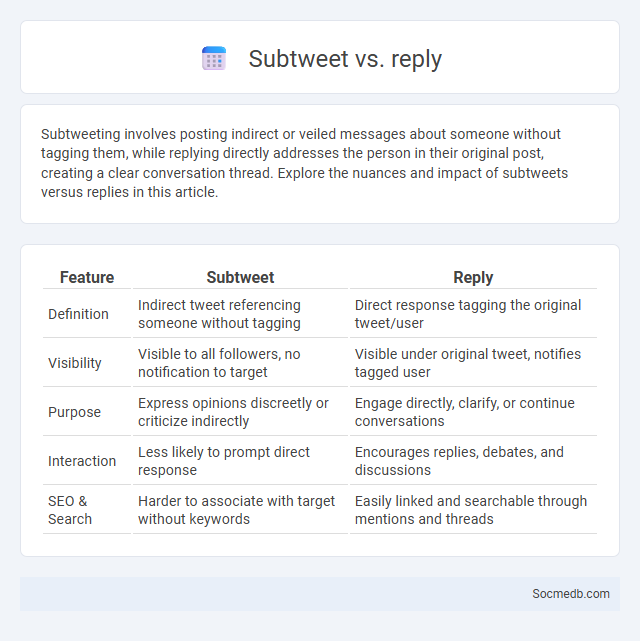
Photo illustration: Subtweet vs Reply
Subtweeting involves posting indirect or veiled messages about someone without tagging them, while replying directly addresses the person in their original post, creating a clear conversation thread. Explore the nuances and impact of subtweets versus replies in this article.
Table of Comparison
| Feature | Subtweet | Reply |
|---|---|---|
| Definition | Indirect tweet referencing someone without tagging | Direct response tagging the original tweet/user |
| Visibility | Visible to all followers, no notification to target | Visible under original tweet, notifies tagged user |
| Purpose | Express opinions discreetly or criticize indirectly | Engage directly, clarify, or continue conversations |
| Interaction | Less likely to prompt direct response | Encourages replies, debates, and discussions |
| SEO & Search | Harder to associate with target without keywords | Easily linked and searchable through mentions and threads |
Understanding the Basics: What is a Subtweet?
A subtweet is a social media post that references or criticizes someone without directly tagging or mentioning their username, often used to convey messages indirectly to a specific audience. This indirect approach allows users to express opinions or address conflicts subtly, creating a layer of ambiguity that can spark curiosity or speculation among followers. Understanding subtweets is essential for navigating online interactions, as they impact communication dynamics and social relationships on platforms like Twitter and Instagram.
The Anatomy of a Reply on Social Media
A reply on social media consists of key elements such as the user's handle, timestamp, and the original post snippet to provide context and maintain conversational flow. Engaging replies often include relevant hashtags, emojis, and concise language to enhance visibility and emotional connection. By crafting your reply with clarity and relevance, you boost interaction and foster meaningful online engagement.
Comparing Subtweet vs Reply: Key Differences
Subtweets refer to indirect mentions of users or topics on social media platforms without tagging them, often used to express opinions or criticisms subtly. Replies are direct responses to a specific user's post, featuring explicit tagging and immediate visibility in conversation threads. Subtweets impact engagement by fostering indirect discourse, while replies encourage direct interaction and clearer communication.
Intent and Tone: Subtweet vs Reply
Subtweets on social media convey indirect commentary or criticism without explicitly naming the subject, creating ambiguity and promoting curiosity among followers. Replies, in contrast, involve direct engagement and clear communication between users, fostering transparency and immediate interaction. The tone in subtweets tends to be passive-aggressive or cryptic, whereas replies maintain a more straightforward and conversational tone.
Contextual Impact: How Subtweets Influence Conversations
Subtweets subtly shape online discussions by indirectly referencing individuals or topics, creating layers of meaning without direct confrontation. Your engagement with subtweets can amplify their influence, fueling curiosity and speculation within social media communities. This strategy often drives viral conversations, as users interpret and respond to nuanced messaging beyond explicit content.
Visibility and Audience: Who Sees Your Subtweets and Replies?
Visibility on social media platforms depends on algorithmic prioritization and user settings, affecting who sees subtweets and replies; subtweets typically appear to your followers and anyone searching specific keywords, while replies are visible primarily to those involved in the conversation and mutual followers. Engaging strategically by tagging relevant users or using popular hashtags can increase the audience reach beyond immediate connections. Understanding platform-specific privacy features and engagement patterns optimizes visibility and influence within targeted social circles.
Subtweet Etiquette: Dos and Don'ts
When navigating social media, practicing proper subtweet etiquette maintains respectful communication and prevents misunderstandings. You should avoid direct attacks or passive-aggressive comments in subtweets, as they can escalate conflicts and harm relationships. Instead, use subtweets thoughtfully to share general observations or humor without targeting specific individuals, ensuring your online interactions remain positive and constructive.
Reply Dynamics: Engaging Directly vs Indirectly
Reply dynamics on social media significantly influence user engagement and relationship building, with direct replies fostering personalized interactions that boost visibility and strengthen community bonds. Indirect responses, such as liking or sharing content without direct messaging, often increase reach but may lack the depth of connection found in direct engagement. Platforms like Twitter and Instagram highlight the effectiveness of direct replies in generating sustained conversations and enhancing algorithmic prioritization of content.
Ethical Considerations: When Subtweeting or Replying Goes Too Far
Subtweeting or replying on social media raises critical ethical concerns related to privacy, harassment, and digital respect. The indirect nature of subtweeting can lead to misunderstandings and cyberbullying, impacting mental health and online reputation. Maintaining transparency and accountability in digital interactions safeguards user trust and promotes healthier social media environments.
Choosing the Best Communication Method: Subtweet or Reply?
Choosing the best communication method on social media depends on the intended impact and audience engagement. A subtweet allows indirect commentary without direct confrontation, preserving ambiguity while signaling to specific followers. In contrast, a reply enables direct interaction, fostering transparent dialogue and immediate response.
 socmedb.com
socmedb.com